|
AND IT'S SIBLING THE RODGERS AND SPENCER PERCUSSION ARMY REVOLVER A TWO PART RAMBLING OF TWO REVOLVERS WITH THE SAME FRONT END!
|
|
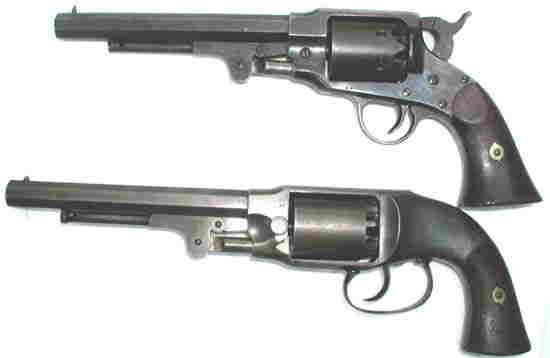
TOP: THE RODGERS AND SPENCER .44 CALIBER SINGLE ACTION PERCUSSION ARMY BOTTOM: THE PETTENGILL .44 CALIBER DOUBLE ACTION PERCUSSION ARMY REVOLVER (See Part 1)
|
|
|
THE ROGERS & SPENCER SINGLE ACTION PERCUSSION ARMY REVOLVER
|
|
|
In 1864, after producing the ill fated Pettengill Army and
Navy size revolvers, Rogers and Spencer started to produce a much
improved firearm bearing their name. They basically retained the
forward part of the frame, barrel and loading lever assemblies of
the Pettengill Percussion Army Revolver probably utilizing the same
machinery to manufacture both. On November 29, 1864, Rogers, Spencer
& Company received a War Department contract for 5,000 of their
revolvers at a cost of $12.00 each. The contract called for 500
to be delivered in January of 1865 and 500 more per each month thereafter
until all of the arms were delivered. They met the contract terms
delivering the last 500 in September of 1865 approximately 4 months
after the cessation of hostilities. The particular weapon pictured
here, serial number 2879, was probably delivered in June of 1865.
Despite the Rodgers & Spencer being among the best of the percussion
military revolvers ever produced none of them were issued for field
service during or after the war. All 5,000 of them were kept in
storage in New York until 1901. At that time the entire lot of them
were sold at auction at a cost to the bidder of around $ .50 each.
Due to this, today we find many of these revolvers in new or nearly
new condition. However, some are also found that show hard usage
indicating that some people found them useful after all. The total
number of Rogers and Spencer arms produced, based on existing serial
numbers, was approximately 5,800 indicating that some were likely
sold on the commercial market.
|
|
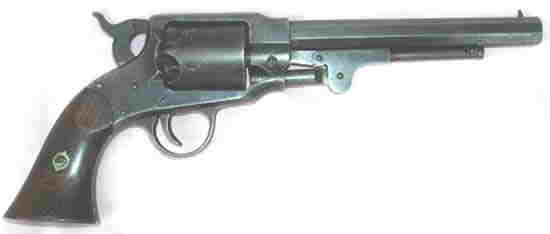
|
|
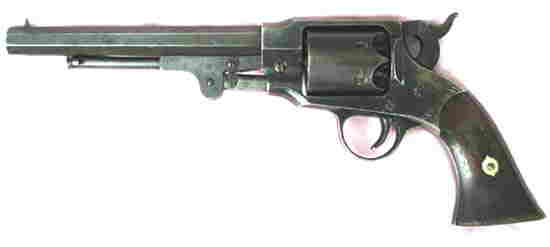
RIGHT & LEFT SIDE VIEWS OF THE ROGERS AND SPENCER .44 CALIBER SINGLE ACTION PERCUSSION ARMY REVOLVER
|
|
|
|
|

LEFT SIDE VIEW OF THE SPENCER & ROGERS ARMY REVOLVER WITH THE COMBINATION LOADING LEVER / CYLINDER ARBOR MECHANISM, LEFT AND RIGHT SET SCREWS AND CYLINDER REMOVED
|
|
|
This single action, six-shot arm is .44 caliber and weighs 3 pounds.
Measured diagonally from the tip of the butt to the muzzle face
it is 14-1/4" overall. The 7-1/2" barrel is rifled with 5 grooves.
The barrel is marked on the top strap "ROGERS & SPENCER / UTICA
N.Y" in two lines. A government inspectors mark of a "B" is stamped
on both the left and right barrel flats near the frame housing.
Centered on the bottom of the barrel is the serial number, "2879".
An "0" is stamped to the rear of the loading lever catch located
1-1/2" on center from the muzzle. The inspector's "B" stampings
are also on both the left and right sides of the upper forward frame,
on the left frame below the hammer, and at the bottom of the frame
to the rear of the trigger guard screw. It is also stamped on the
left side of the hammer and the left side of the combination loading
lever and cylinder arbor near the frame as well as towards the rear
of the cylinder between two of the beveled, semi-circular nipple
wells, and in front of the mis-stamped serial number on the cylinder.
That stamping consists of an upside down "3" followed by "879".
The correct serial number stamping of "2879" is also on the
left frame under the cylinder opening, on the bottom of the grip
strap, on the top of the combination loading lever and cylinder
arbor assembly (twice) and inside both grips. On the bottom of the
frame in front of the trigger guard screw is the stamping of a small
shield. The cartouche of the inspector's initials is stamped in
the left grip of the two-piece, oil-finished walnut grips. Although
quite faint they are "RPB" for Robert P. Barry, Captain U.S.A.,
1860-1865.
|
|
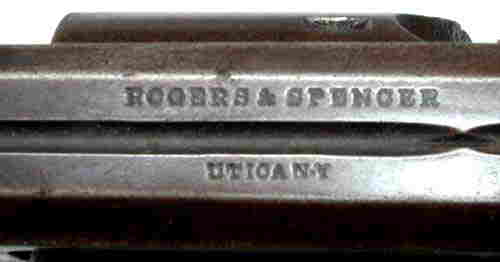
"ROGERS & SPENCER / UTICA N.Y" STAMPING -TOP OF FRAME (ALSO NOTE SIGHTING GROOVE)
|
|
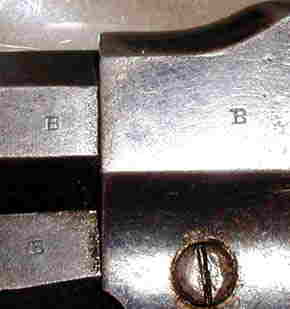
|
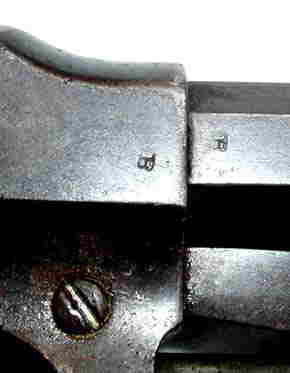
|

|

|
|
|
|
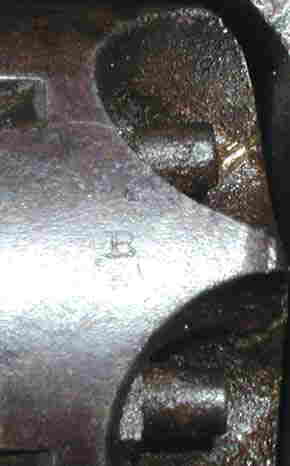
"B" ON CYLINDER BETWEEN NIPPLE WELLS
|
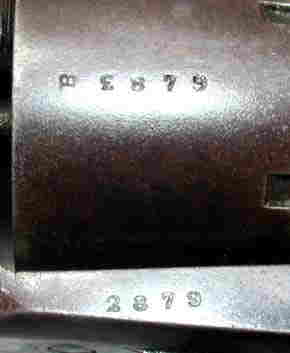
SERIAL NUMBER "2879" STAMPING CYLINDER* AND LEFT FRAME (* MIS-STAMPED)
|

NUMBER "0" AND SERIAL NUMBER "2879"ON BOTTOM BARREL FLAT
|
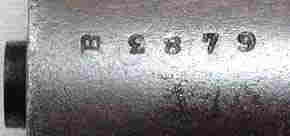
CLOSE UP OF MIS-STAMPED SERIAL NUMBER (UPSIDE DOWN "3" PLUS "879")
|
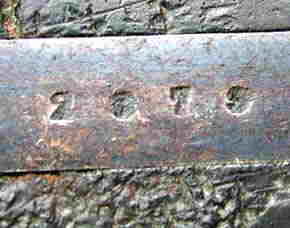
SERIAL NUMBER "2879" ON BUTT STRAP
|

SERIAL NUMBER "2879" ON RAM ROD / CYLINDER ARBOR PIN
|
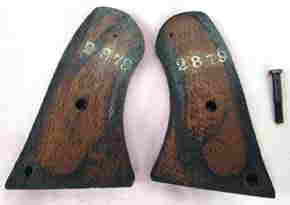
SERIAL NUMBER "2879"INSIDE GRIPS
|

LEFT GRIP CARTOUCHE (FAINT) ("RPB" for Robert P. Barry, Captain U.S.A., 1860-1865)
|
|
|
|
|
There is a high German silver
cone front sight set 3/8", on center, from the muzzle face. The
rear sight is formed by a pinched "V" groove formed into the top
strap. The blued, solid frame is marked as described above. At the
front of the cylinder the frame drops vertically enclosing the barrel
threads. There is a cone shaped loading groove at the lower right
of the frame. A somewhat flat recoil shield behind the cylinder
is cast integral to the frame. A semi-circular capping groove is
present in the right side recoil shield. The hammer was originally
case-hardened. The blued six chamber 2 inch long cylinder has rectangular
shaped stop slots. The nipples are recessed in beveled, semi-circular
wells. The one piece grip straps and trigger guard are blue finished
as is the trigger. The two screws at the rear of the frame serve
to properly position the grip straps. The case-hardened loading
lever has a plunger type latch that is held by a catch mortised
into the bottom of the barrel 1-1/2" from the muzzle. The loading
lever/cylinder arbor assembly is held in place by set screws which
enter the frame from each side just forward of the cylinder. These
set screws must be removed to free the cylinder. The black walnut
two piece grips flare out quite noticeably at the butt giving this
arm a unique appearance.
|
|
|
If I have one criticism of this arm, it is the set screws. It is
always easier to load the cylinder when it is out of the gun. The
user would need a screw driver to remove these set screws if he
wished to take the cylinder out each time he loaded the weapon.
A prospect fraught with problems when in the field.
|
|

FRONT CONE SIGHT
|

SET SCREWS FOR RELEASING LOADING LEVER / CYLINDER ARBOR
|
 |
 |
|
|
|
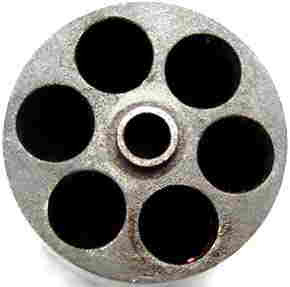
FRONT CYLINDER VIEW
|

REAR CYLINDER VIEW
|
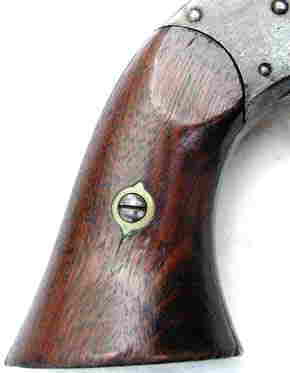 |
 |
|
|
|

|
|

|
|
|
|
|
|
|
|
|
The next posting will feature a Civil War presentation grade
sword by H. Sauerbier of Newark, N.J.. Sauerbier presentation
swords are very interesting as he utilized various designs and inlays
on his scabbards & hilts. No two of his presentation swords
are identical. Each one is a separate work of the sword maker's
art.
|
|
|
Reference material for this posting came from "U.S. Military
Small Arms 1816-1865" by Robert M. Reilly, "Civil
War Small Arms", an American Rifleman Reprint - Articles
"Civil War Revolvers Part 1 & 2 of 2" by C. Meade
Patterson & Cuddy De Marco, Jr. and Norm Flayderman's "Flayderman's
Guide To Antique American Firearms... And Their Values".
|
|
| The photographs are all originals of mine as are any assumptions or errors in this posting. The ace webmaster is Reed Radcliffe, my son, who puts this all together for your viewing. | |
|
|
|
|
|
|
|
|
|
| Dave Radcliffe | |